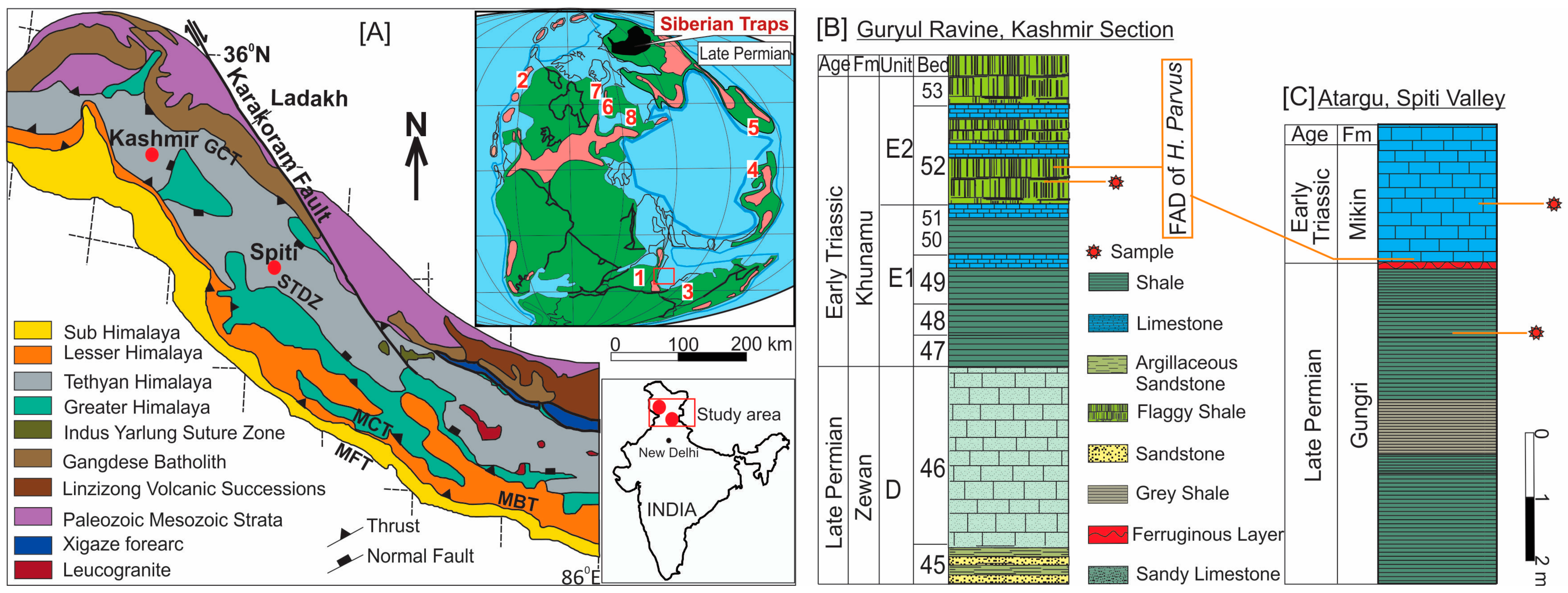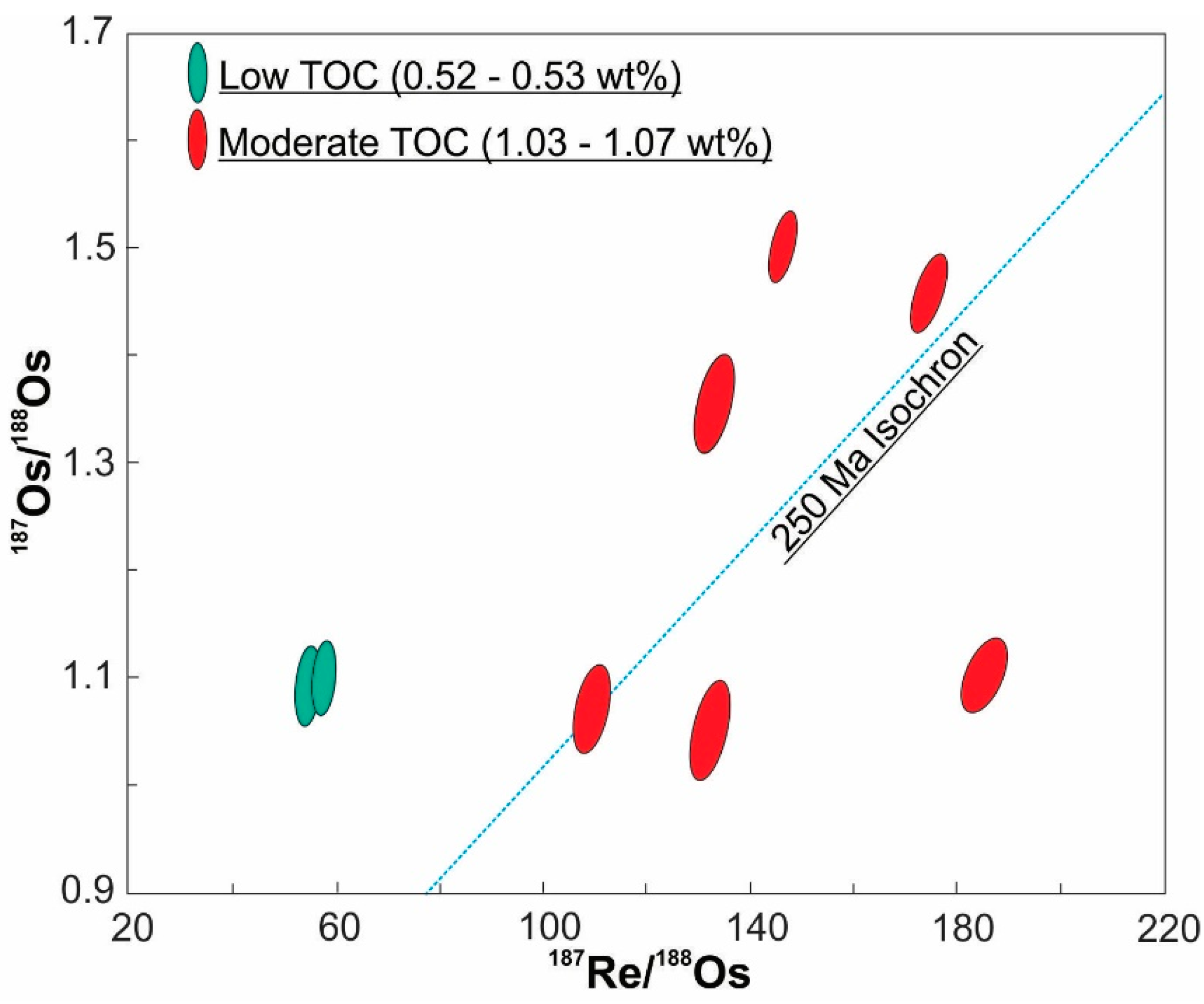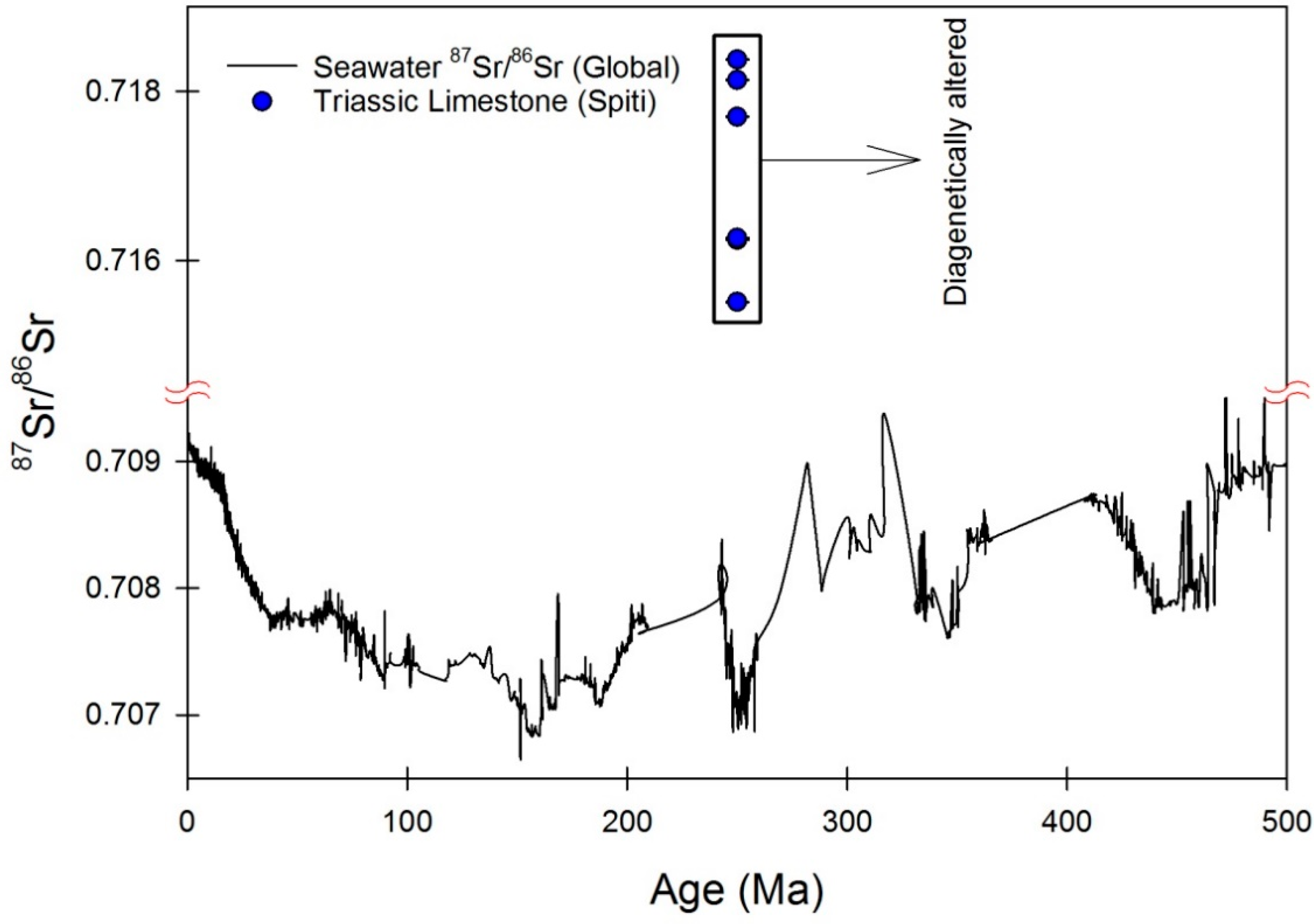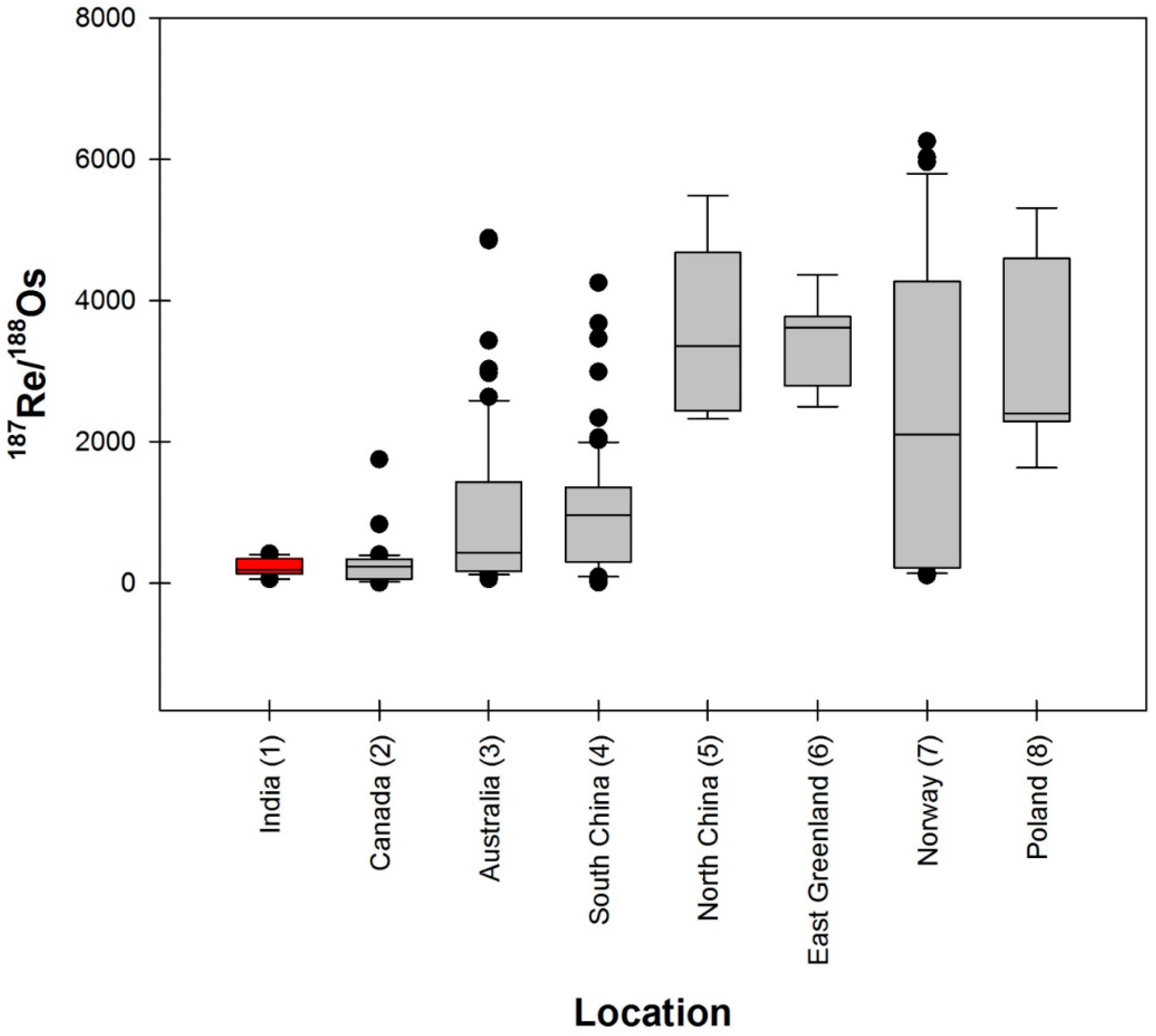Re–Os and Sr Isotopic Study of Permian–Triassic Sedimentary Rocks from the Himalaya: Shale Chronology and Carbonate Diagenesis
Abstract
:1. Introduction
2. Geological Settings
3. Materials and Methods
4. Results
5. Discussion
5.1. Re–Os Depositional Age
5.2. 87Sr/86Sr of Early Triassic (Induan) Carbonates, Mikin Formation Post-Depositional Diagenesis
5.3. Global Distribution of 187Re/188Os during the Late Permian
6. Conclusions
Author Contributions
Funding
Data Availability Statement
Acknowledgments
Conflicts of Interest
References
- Erwin, D.H. The Great Paleozoic Crisis: Life and Death in the Permian; Columbia University Press: New York, NY, USA, 1993; p. 327. [Google Scholar]
- Erwin, D.H. Impact at the Permo-Triassic Boundary: A Critical Evaluation. Astrobiology 2003, 3, 67–74. [Google Scholar] [CrossRef]
- Knoll, A.H.; Bambach, R.K.; Canfield, D.E.; Grotzinger, J.P. Comparative Earth History and Late Permian Mass Extinction. Science 1996, 273, 452–457. [Google Scholar] [CrossRef]
- Xie, S.; Pancost, R.D.; Huang, J.; Wignall, P.B.; Yu, J.; Tang, X.; Chen, L.; Huang, X.; Lai, X. Changes in the global carbon cycle occurred as two episodes during the Permian–Triassic crisis. Geology 2007, 35, 1083. [Google Scholar] [CrossRef]
- Song, H.; Wignall, P.B.; Tong, J.; Yin, H. Two pulses of extinction during the Permian-Triassic crisis. Nat. Geosci. 2012, 6, 52–56. [Google Scholar] [CrossRef]
- Renne, P.R.; Black, M.T.; Zichao, Z.; Richards, M.A.; Basu, A.R. Synchrony and Causal Relations Between Permian-Triassic Boundary Crises and Siberian Flood Volcanism. Science 1995, 269, 1413–1416. [Google Scholar] [CrossRef] [Green Version]
- Payne, J.; Kump, L. Evidence for recurrent Early Triassic massive volcanism from quantitative interpretation of carbon isotope fluctuations. Earth Planet. Sci. Lett. 2007, 256, 264–277. [Google Scholar] [CrossRef]
- Georgiev, S.; Stein, H.J.; Hannah, J.L.; Bingen, B.; Weiss, H.M.; Piasecki, S. Hot acidic Late Permian seas stifle life in record time. Earth Planet. Sci. Lett. 2011, 310, 389–400. [Google Scholar] [CrossRef]
- Shen, S.-Z.; Cao, C.-Q.; Zhang, H.; Bowring, S.A.; Henderson, C.M.; Payne, J.L.; Davydov, V.I.; Chen, B.; Yuan, D.-X.; Zhang, Y.-C.; et al. High-resolution δ13Ccarb chemostratigraphy from latest Guadalupian through earliest Triassic in South China and Iran. Earth Planet. Sci. Lett. 2013, 375, 156–165. [Google Scholar] [CrossRef]
- Burgess, S.D.; Muirhead, J.D.; Bowring, S.A. Initial pulse of Siberian Traps sills as the trigger of the end-Permian mass extinction. Nat. Commun. 2017, 8, 1–6. [Google Scholar] [CrossRef] [Green Version]
- Shukla, A.D.; Bhandari, N.; Shukla, P.N. Chemical signatures of the Permian-Triassic transitional environment in Spiti Valley, India. Geol. Soc. Am. Spec. Pap. 2002, 356, 445–454. [Google Scholar] [CrossRef]
- Ghosh, N.; Basu, A.R.; Bhargava, O.; Shukla, U.; Ghatak, A.; Garzione, C.N.; Ahluwalia, A.D. Catastrophic environmental transition at the Permian-Triassic Neo-Tethyan margin of Gondwanaland: Geochemical, isotopic and sedimentological evidence in the Spiti Valley, India. Gondwana Res. 2016, 34, 324–345. [Google Scholar] [CrossRef]
- Algeo, T.J.; Chen, Z.Q.; Fraiser, M.L.; Twitchett, R.J. Terrestrial-marine teleconnections in the collapse and rebuilding of Early Triassic marine ecosystems. Palaeogeogr. Palaeoclimatol. Palaeoecol. 2011, 308, 1–11. [Google Scholar] [CrossRef]
- Zhang, F.; Algeo, T.J.; Romaniello, S.J.; Cui, Y.; Zhao, L.; Chen, Z.-Q.; Anbar, A.D. Congruent Permian-Triassic δ238U records at Panthalassic and Tethyan sites: Confirmation of global-oceanic anoxia and validation of the U-isotope paleoredox proxy. Geology 2018, 46, 327–330. [Google Scholar] [CrossRef]
- Penn, J.L.; Deutsch, C.; Payne, J.L.; Sperling, E.A. Temperature-dependent hypoxia explains biogeography and severity of end-Permian marine mass extinction. Yearb. Paediatr. Endocrinol. 2019, 362, 11–30. [Google Scholar] [CrossRef]
- Song, H.; Huang, S.; Jia, E.; Dai, X.; Wignall, P.B.; Dunhill, A.M. Flat latitudinal diversity gradient caused by the Permian-Triassic mass extinction. Proc. Natl. Acad. Sci. USA 2020, 117, 17578–17583. [Google Scholar] [CrossRef]
- Garzanti, E.; Nicora, A.; Rettori, R. Permo-Triassic boundary and Lower to Middle Triassic in South Tibet. J. Asian Earth Sci. 1998, 16, 143–157. [Google Scholar] [CrossRef]
- Algeo, T.J.; Hannigan, R.; Rowe, H.; Brookfield, M.; Baud, A.; Krystyn, L.; Ellwood, B.B. Sequencing events across the Permian–Triassic boundary, Guryul Ravine (Kashmir, India). Palaeogeogr. Palaeoclim. Palaeoecol. 2007, 252, 328–346. [Google Scholar] [CrossRef]
- Bhargava, O.N.; Krystyn, L.; Balini, M.; Lein, R.; Nicora, A. Revised litho and sequence stratigraphy of the Spiti Triassic. Albertiana 2004, 30, 21–39. [Google Scholar]
- Tewari, R.; Pandita, S.K.; McLoughlin, S.; Agnihotri, D.; Pillai, S.S.; Singh, V.; Kumar, K.; Bhat, G.D. The Permian-Triassic paly-nological transition in the Guryul Ravine section, Kashmir, India: Implications for Tethyan-Gondwanan correlations. Earth Sci. Rev. 2015, 149, 53–66. [Google Scholar] [CrossRef] [Green Version]
- Brookfield, M.; Shellnutt, J.; Qi, L.; Hannigan, R.; Bhat, G.; Wignall, P. Platinum element group variations at the Permo-Triassic boundary in Kashmir and British Columbia and their significance. Chem. Geol. 2010, 272, 12–19. [Google Scholar] [CrossRef]
- Williams, J.C.; Basu, A.R.; Bhargava, O.N.; Ahluwalia, A.D.; Hannigan, R.E. Resolving original signatures from a sea of over-print—The geochemistry of the Gungri Shale (Upper Permian, Spiti Valley, India). Chem. Geol. 2012, 324, 59–72. [Google Scholar] [CrossRef]
- Stebbins, A.; Williams, J.; Brookfield, M.; Nye, S.W., Jr.; Hannigan, R. Frequent euxinia in southern Neo-Tethys Ocean prior to the end-Permian biocrisis: Evidence from the Spiti region, India. Palaeogeogr. Palaeoclim. 2019, 516, 1–10. [Google Scholar] [CrossRef]
- Krystyn, L.; Balini, M.; Nicora, A. Lower and Middle Triassic stage and substage boundaries in Spiti. Albertiana 2004, 30, 40–53. [Google Scholar]
- Bhargava, O.N. An updated introduction to the Spiti geology. J. Palaeontol. Soc. 2008, 53, 113–128. [Google Scholar]
- Ravizza, G.; Turekian, K.K. Application of the 187Re-187Os system to black shale geochronometry. Geochim. Cosmochim. Acta 1989, 53, 3257–3262. [Google Scholar] [CrossRef]
- Selby, D.; Creaser, R.A. Direct radiometric dating of the Devonian-Missippian time-scale boundary using the Re–Os black shale geochronometer. Geology 2005, 33, 545–548. [Google Scholar] [CrossRef]
- Kendall, B.; Creaser, R.A.; Gordon, G.W.; Anbar, A.D. Re-Os and Mo isotope systematics of black shales from the Middle Proterozoic Velkerri and Wollogorang Formations, McArthur Basin, northern Australia. Geochim. Cosmochim. Acta 2009, 73, 2534–2558. [Google Scholar] [CrossRef]
- Tripathy, G.R.; Hannah, J.L.; Stein, H.J. Refining the Jurassic-Cretaceous boundary: Re–Os geochronology and depositional envi-ronment of Upper Jurassic shales from the Norwegian Sea. Palaeogeogr. Palaeoclim. Palaeoecol. 2018, 503, 13–25. [Google Scholar] [CrossRef]
- Yang, G.; Hannah, J.; Zimmerman, A.; Stein, H.; Bekker, A. Re-Os depositional age for Archean carbonaceous slates from the southwestern Superior Province: Challenges and insights. Earth Planet. Sci. Lett. 2009, 280, 83–92. [Google Scholar] [CrossRef]
- Rooney, A.D.; Macdonald, F.A.; Strauss, J.V.; Dudas, F.O.; Hallmann, C.; Selby, D. Re–Os geochronology and coupled Os–Sr isotope constraints on the Sturtian snowball Earth. Proc. Natl. Acad. Sci. USA 2014, 111, 51–56. [Google Scholar] [CrossRef] [Green Version]
- Pašava, J.; Zaccarini, F.; Aiglsperger, T.; Vymazalová, A. Platinum-group elements (PGE) and their principal carriers in metal-rich black shales: An overview with a new data from Mo-Ni-PGE black shales (Zunyi region, Guizhou Province, south China). J. Geosci. 2013, 58, 209–216. [Google Scholar] [CrossRef]
- Georgiev, S.V.; Stein, H.J.; Yang, G.; Hannah, J.L.; Böttcher, M.E.; Grice, K.; Holman, A.I.; Turgeon, S.; Simonsen, S.; Cloquet, C. Late Permian-Early Triassic environmental changes recorded by multi-isotope (Re–Os–N–Hg) data and trace metal distribution from the Hovea-3 section, Western Australia. Gondwana Res. 2020, 88, 353–372. [Google Scholar] [CrossRef]
- Liu, Z.; Selby, D.; Zhang, H.; Zheng, Q.; Shen, S.; Sageman, B.B.; Grasby, S.E.; Beauchamp, B. Osmium-isotope evidence for vol-canism across the Wuchiapingian-Changhsingian boundary interval. Chem. Geol. 2019, 529, 119313. [Google Scholar] [CrossRef]
- Liu, Z.; Selby, D.; Zhang, H.; Shen, S. Evidence for volcanism and weathering during the Permian-Triassic mass extinction from Meishan (South China) osmium isotope record. Palaeogeogr. Palaeoclim. Palaeoecol. 2020, 553, 109790. [Google Scholar] [CrossRef]
- Veizer, J.; Ala, D.; Azmy, K.; Bruckschen, P.; Buhl, D.; Bruhn, F.; Carden, G.A.; Diener, A.; Ebneth, S.; Godderis, Y.; et al. 87Sr/86Sr, δ13C and δ18O evolution of Phanerozoic seawater. Chem. Geol. 1999, 161, 59–88. [Google Scholar] [CrossRef] [Green Version]
- Hu, X.-M.; Garzanti, E.; An, W. Provenance and drainage system of the Early Cretaceous volcanic detritus in the Himalaya as constrained by detrital zircon geochronology. J. Palaeogeogr. 2015, 4, 85–98. [Google Scholar] [CrossRef] [Green Version]
- Scotese, C.R.; Golonka, J. Paleomap Project, Paleogeographic Atlas; University of Texas at Arlington: Arlington, TX, USA, 1997; pp. 1–45. [Google Scholar]
- Kapoor, H.M. The Guryul ravine section, candidate of the global stratotype and point (GSSP) of the Permian-Triassic boundary (PTB). In The Paleozoic-Mesozoic Boundary: Candidates of the Global Stratotype Section and Point of the Permian-Triassic Boundary; Yin, H., Ed.; China University Geosciences Press: Wuhan, China, 1996; pp. 99–110. [Google Scholar]
- Brookfield, M.E.; Twitchett, R.J.; Goodings, C. Palaeoenvironments of the Permian-Triassic transition sections in Kashmir, India. Palaeogeogr. Palaeoclim. Palaeoecol. 2003, 198, 353–371. [Google Scholar] [CrossRef]
- Tripathy, G.R.; Singh, S.K.; Bhu, H. ReOs isotopes and major and trace element geochemistry of carbonaceous shales, Aravalli Supergroup, India: Impact of post-depositional processes. Chem. Geol. 2013, 354, 93–106. [Google Scholar] [CrossRef]
- Ackerman, L.; Pašava, J.; Šípková, A.; Martínková, E.; Haluzová, E.; Rodovská, Z.; Chrastný, V. Copper, zinc, chromium and osmium isotopic compositions of the Teplá-Barrandian unit black shales and implications for the composition and oxygenation of the Neoprotero-zoic-Cambrian ocean. Chem. Geol. 2019, 521, 59–75. [Google Scholar] [CrossRef]
- Selby, D.; Creaser, R.A. Re–Os geochronology of organic rich sediments: An evaluation of organic matter analysis methods. Chem. Geol. 2003, 200, 225–240. [Google Scholar] [CrossRef]
- Cohen, A.S.; Waters, F. Separation of osmium from geological materials by solvent extraction for analysis by thermal ionisation mass spectrometry. Anal. Chim. Acta 1996, 332, 269–275. [Google Scholar] [CrossRef]
- Birck, J.L.; Barman, M.R.; Capmas, F. Re–Os Isotopic Measurements at the Femtomole Level in Natural Samples. Geostand. Geoanal. Res. 1997, 21, 19–27. [Google Scholar] [CrossRef]
- Rahaman, W.; Singh, S.K.; Sinha, R.; Tandon, S. Sr, C and O isotopes in carbonate nodules from the Ganga Plain: Evidence for recent abrupt rise in dissolved 87Sr/86Sr ratios of the Ganga. Chem. Geol. 2011, 285, 184–193. [Google Scholar] [CrossRef]
- Weis, D.; Kieffer, B.; Maerschalk, C.; Barling, J.; De Jong, J.; Williams, G.A.; Hanano, D.; Pretorius, W.; Mattielli, N.; Scoates, J.S.; et al. High-precision isotopic characterization of USGS reference materials by TIMS and MC-ICP-MS. Geochem. Geophy. Geosy. 2006, 7, 8. [Google Scholar] [CrossRef]
- Danish, M.; Tripathy, G.R.; Panchang, R.; Gandhi, N.; Prakash, S. Dissolved boron in a brackish-water lagoon system (Chilika lagoon, India): Spatial distribution and coastal behavior. Mar. Chem. 2019, 214, 103663. [Google Scholar] [CrossRef]
- Peucker-Ehrenbrink, B.; Jahn, B.-M. Rhenium-osmium isotope systematics and platinum group element concentrations: Loess and the upper continental crust. Geochem. Geophys. Geosyst. 2001, 2. [Google Scholar] [CrossRef]
- Lu, X.; Kendall, B.; Stein, H.; Hannah, J. Temporal record of osmium concentrations and 187Os/188Os in organic-rich mudrocks: Implications for the osmium geochemical cycle and the use of osmium as a paleoceanographic tracer. Geochim. Cosmochim. Acta. 2017, 216, 221–241. [Google Scholar] [CrossRef]
- Sheen, A.I.; Kendall, B.; Reinhard, C.T.; Creaser, R.A.; Lyons, T.W.; Bekker, A.; Poulton, S.W.; Anbar, A.D. A model for the oceanic mass balance of rhenium and implications for the extent of Proterozoic ocean anoxia. Geochim. Cosmochim. Acta 2018, 227, 75–95. [Google Scholar] [CrossRef] [Green Version]
- Ludwig, K. Isoplot/Ex Version 3.75, A Geochronological Toolkit for Microsoft Excel; Berkeley Geochronology Center: Berkeley, CA, USA, 2012; Volume 5, p. 75. [Google Scholar]
- Rudnick, R.L.; Gao, S. Composition of the continental crust. In The Crust; Holland, H.D., Turekian, K.K., Eds.; University of Maryland: College Park, MD, USA, 2003; Volume 3, pp. 1–64. [Google Scholar]
- McArthur, J.M.; Algeo, T.J.; Van De Schootbrugge, B.; Li, Q.; Howarth, R.J. Basinal restriction, black shales, Re–Os dating and the Early Toarcian (Jurassic) oceanic anoxic event. Paleoceanography 2008, 23, 1–22. [Google Scholar] [CrossRef] [Green Version]
- Jaffe, L.A.; Peucker-Ehrenbrink, B.; Petsch, S.T. Mobility of rhenium, platinum group elements and organic carbon during black shale weathering. Earth Planet. Sci. Lett. 2002, 198, 339–353. [Google Scholar] [CrossRef]
- Tripathy, G.R.; Singh, S.K. Re–Os depositional age for black shales from the Kaimur Group, Upper Vindhyan, India. Chem. Geol. 2015, 413, 63–72. [Google Scholar] [CrossRef]
- McArthur, J.; Howarth, R.; Shields, G. Strontium Isotope Stratigraphy. Geol. Time Scale 2012, 1, 127–144. [Google Scholar] [CrossRef]
- Singh, S.K.; Trivedi, J.; Pande, K.; Ramesh, R.; Krishnaswami, S. Chemical and Strontium, Oxygen and Carbon Isotopic Compositions of Carbonates from the Lesser Himalaya: Implications to the Strontium Isotope Composition of the Source Waters of the Ganga, Ghaghara, and the Indus Rivers. Geochim. Cosmochim. Acta 1998, 62, 743–755. [Google Scholar] [CrossRef]
- Tucker, M.E. Sedimentary Petrology; Blackwell Science: Hoboken, NJ, USA, 1991. [Google Scholar]
- Garaguly, I.; Varga, A.; Raucsik, B.; Schubert, F.; Czuppon, G.; Frei, R. Pervasive early diagenetic dolomitization, subsequent hydrothermal alteration, and late stage hydrocarbon accumulation in a Middle Triassic carbonate sequence (Szeged Basin, SE Hungary). Mar. Pet. Geol. 2018, 98, 270–290. [Google Scholar] [CrossRef]
- Warren, J. Dolomite: Occurrence, evolution and economically important associations. Earth Sci. Rev. 2000, 52, 1–81. [Google Scholar] [CrossRef]
- Banner, J.L. Application of the trace element and isotope geochemistry of strontium to studies of carbonate diagenesis. Sedimentology 1995, 42, 805–824. [Google Scholar] [CrossRef]
- Veizer, J. Chemical diagenesis of carbonates: Theory and application. Stable Isot. Sediment. Geol. 1983, 10, 3–100. [Google Scholar]
- Derry, L.A.; Kaufman, A.J.; Jacobsen, S.B. Sedimentary cycling and environmental change in the Late Proterozoic: Evidence from stable and radiogenic isotopes. Geochim. Cosmochim. Acta 1992, 56, 1317–1329. [Google Scholar] [CrossRef]
- Tucker, M.E.; Hollingworth, N.T.J. The Upper Permian Reef Complex (EZ1) of North East England: Diagenesis in a Marine to Evaporitic Setting; Metzler, J.B., Ed.; Springer: Berlin/Heidelberg, Germany, 1986; pp. 270–290. [Google Scholar]
- Worden, R.H.; Burley, S.D. Sandstone Diagenesis: The Evolution of Sand to Stone. In Sandstone Diagenesis; John Wiley & Sons: Hoboken, NJ, USA, 2009; pp. 1–44. [Google Scholar]
- Bickle, M.J.; Harris, N.B.W.; Bunbury, J.M.; Chapman, H.J.; Fairchild, I.J.; Ahmad, T. Controls on the 87Sr/86Sr Ratio of Carbonates in the Garhwal Himalaya, Headwaters of the Ganges. J. Geol. 2001, 109, 737–753. [Google Scholar] [CrossRef] [Green Version]
- Ravizza, G.; Turekian, K.; Hay, B. The geochemistry of rhenium and osmium in recent sediments from the Black Sea. Geochim. Cosmochim. Acta 1991, 55, 3741–3752. [Google Scholar] [CrossRef]
- Peucker-Ehrenbrink, B.; Ravizza, G. The marine osmium isotope record. Terra Nova 2000, 12, 205–219. [Google Scholar] [CrossRef]
- Yang, G.; Chen, J.; Du, A.; Qu, W.; Yu, G. Re–Os dating of Mo-bearing black shale of the Laoyaling deposit, Tongling, Anhui Province, China. Chin. Sci. Bull. 2004, 49, 1396–1400. [Google Scholar] [CrossRef]
- Georgiev, S.V.; Stein, H.J.; Hannah, J.L.; Henderson, C.M.; Algeo, T.J. Enhanced recycling of organic matter and Os-isotopic evidence for multiple magmatic or meteoritic inputs to the Late Permian Panthalassic Ocean, Opal Creek, Canada. Geochim. Cosmochim. Acta 2015, 150, 192–210. [Google Scholar] [CrossRef]
- Black, B.A.; Neely, R.R.; Lamarque, J.-F.; Elkins-Tanton, L.T.; Kiehl, J.T.; Shields, C.A.; Mills, M.J.; Bardeen, C. Systemic swings in end-Permian climate from Siberian Traps carbon and sulfur outgassing. Nat. Geosci. 2018, 11, 949–954. [Google Scholar] [CrossRef]
- Racionero-Gómez, B.; Sproson, A.; Selby, D.; Gannoun, A.; Gröcke, D.; Greenwell, H.; Burton, K. Osmium uptake, distribution, and 187Os/188Os and 187Re/188Os compositions in Phaeophyceae macroalgae, Fucus vesiculosus: Implications for determining the 187Os/188Os composition of seawater. Geochim. Cosmochim. Acta 2017, 199, 48–57. [Google Scholar] [CrossRef] [Green Version]
- Racionero-Gómez, B.; Sproson, A.D.; Selby, D.; Gröcke, D.R.; Redden, H.; Greenwell, H.C. Rhenium uptake and distribution in phaeophyceae macroalgae, Fucus vesiculosus. R. Soc. Open Sci. 2016, 3, 160161. [Google Scholar] [CrossRef] [PubMed] [Green Version]
- Rooney, A.D.; Selby, D.; Lloyd, J.M.; Roberts, D.H.; Lückge, A.; Sageman, B.B.; Prouty, N.G. Tracking millennial-scale Holocene glacial advance and retreat using osmium isotopes: Insights from the Greenland ice sheet. Quat. Sci. Rev. 2016, 138, 49–61. [Google Scholar] [CrossRef] [Green Version]







| Sample ID | CaCO3 (wt%) | TOC (wt%) | Re (ng/g) | Os (pg/g) | 192Os (pg/g) | 187Re/188Os | 187Os / 188Os | Rho * |
|---|---|---|---|---|---|---|---|---|
| Gungri Formation, Atargu, Spiti valley | ||||||||
| ASL16/14 | 0.33 | 1.57 | 10.08 ± 0.03 | 151 ± 1 | 48 | 416 ± 4 | 2.355 ± 0.028 | 0.79 |
| ASL16/14F | 0.14 | 1.45 | 7.70 ± 0.04 | 104 ± 1 | 32 | 473 ± 3 | 2.623 ± 0.017 | 0.44 |
| ASL16/18 | 0.50 | 1.36 | 6.07 ± 0.02 | 95 ± 1 | 31 | 393 ± 6 | 2.255 ± 0.041 | 0.75 |
| ASL16/16A | 0.08 | 1.35 | 4.27 ± 0.03 | 90 ± 1 | 31 | 278 ± 4 | 1.826 ± 0.034 | 0.70 |
| ASL16/16B | 0.17 | 1.32 | 4.60 ± 0.03 | 103 ± 1 | 36 | 257 ± 4 | 1.665 ± 0.030 | 0.67 |
| ASL16/20A | 1.00 | 1.39 | 5.38 ± 0.03 | 106 ± 2 | 36 | 300 ± 3 | 1.860 ± 0.034 | 0.61 |
| ASL16/20B | 0.67 | 1.39 | 5.47 ± 0.03 | 96 ± 1 | 31 | 347 ± 6 | 2.115 ± 0.041 | 0.75 |
| ASL16-20C | 0.75 | 1.42 | 5.70 ± 0.03 | 97 ± 1 | 32 | 358 ± 6 | 2.135 ± 0.040 | 0.75 |
| Khunamuh Formation, Guryul Ravine, Kashmir | ||||||||
| GR15-E2/15A1 | b.d. | 1.06 | 1.71 ± 0.02 | 72 ± 1 | 26 | 133 ± 3 | 1.356 ± 0.038 | 0.54 |
| GR15-E2/15A2 | b.d. | 1.03 | 2.64 ± 0.03 | 77 ± 1 | 28 | 185 ± 4 | 1.103 ± 0.028 | 0.47 |
| GR15-E2/15B1 | b.d. | 1.07 | 1.35 ± 0.02 | 66 ± 1 | 24 | 109 ± 3 | 1.072 ± 0.034 | 0.41 |
| GR15-E2/15B2 | b.d. | 1.05 | 1.69 ± 0.02 | 69 ± 1 | 25 | 132 ± 3 | 1.052 ± 0.038 | 0.48 |
| GR15-E2/15C1 | b.d. | 1.05 | 2.70 ± 0.02 | 105 ± 1 | 37 | 146 ± 2 | 1.501 ± 0.027 | 0.58 |
| GR15-E2/15C2 | b.d. | 1.06 | 2.86 ± 0.02 | 92 ± 1 | 33 | 175 ± 3 | 1.459 ± 0.029 | 0.6 |
| GR15-E2/15D1 | b.d. | 0.53 | 0.82 ± 0.02 | 77 ± 1 | 28 | 58 ± 2 | 1.101 ± 0.028 | 0.3 |
| GR15-E2/15D2 | b.d. | 0.52 | 0.73 ± 0.02 | 73 ± 1 | 27 | 54 ± 2 | 1.093 ± 0.031 | 0.28 |
| Sample ID | CaCO3 (wt%) | Mn | Sr | 87Sr/86Sr in Carbonate Leaches * | |
|---|---|---|---|---|---|
| µg/g | 10% Acetic Acid | 0.1 N HCl | |||
| ASL16/02 | 52.1 | 10206 | 610 | 0.717698 ± 0.000004 | 0.717159 ± 0.000004 |
| ASL16/03 | 87.1 | 8800 | 543 | 0.715508 ± 0.000003 | 0.715320 ± 0.000003 |
| ASL16/04 | 90.4 | 11047 | 1182 | 0.718374 ± 0.000004 | 0.718322 ± 0.000004 |
| ASL16/05 | 84.3 | 10198 | 885 | 0.718132 ± 0.000003 | 0.717911 ± 0.000003 |
| ASL16/05R | - | - | - | - | 0.717903 ± 0.000003 |
| ASL16/06 | 86.3 | 4664 | 815 | 0.716243 ± 0.000004 | 0.716198 ± 0.000003 |
| ASL16/06R | - | - | - | 0.716266 ± 0.000004 | - |
Publisher’s Note: MDPI stays neutral with regard to jurisdictional claims in published maps and institutional affiliations. |
© 2021 by the authors. Licensee MDPI, Basel, Switzerland. This article is an open access article distributed under the terms and conditions of the Creative Commons Attribution (CC BY) license (https://creativecommons.org/licenses/by/4.0/).
Share and Cite
Mandal, A.; Tripathy, G.R.; Goswami, V.; Ackerman, L.; Parcha, S.K.; Chandra, R. Re–Os and Sr Isotopic Study of Permian–Triassic Sedimentary Rocks from the Himalaya: Shale Chronology and Carbonate Diagenesis. Minerals 2021, 11, 417. https://doi.org/10.3390/min11040417
Mandal A, Tripathy GR, Goswami V, Ackerman L, Parcha SK, Chandra R. Re–Os and Sr Isotopic Study of Permian–Triassic Sedimentary Rocks from the Himalaya: Shale Chronology and Carbonate Diagenesis. Minerals. 2021; 11(4):417. https://doi.org/10.3390/min11040417
Chicago/Turabian StyleMandal, Anirban, Gyana Ranjan Tripathy, Vineet Goswami, Lukáš Ackerman, Suraj K. Parcha, and Rakesh Chandra. 2021. "Re–Os and Sr Isotopic Study of Permian–Triassic Sedimentary Rocks from the Himalaya: Shale Chronology and Carbonate Diagenesis" Minerals 11, no. 4: 417. https://doi.org/10.3390/min11040417






